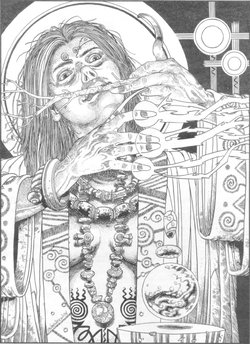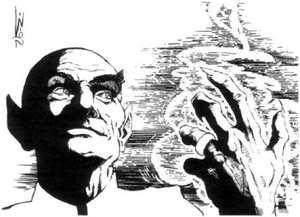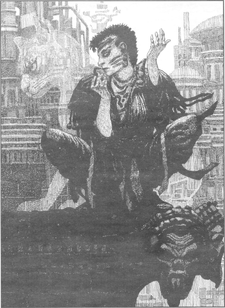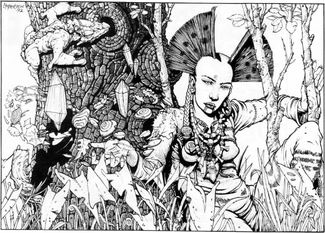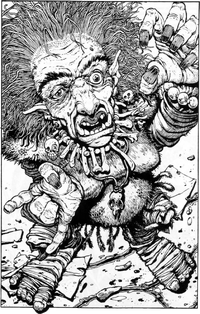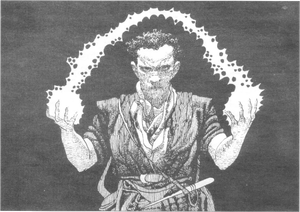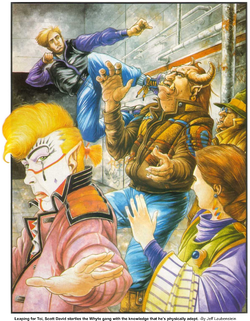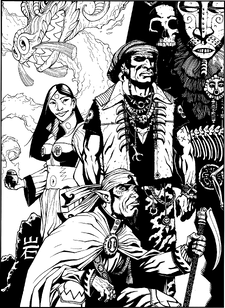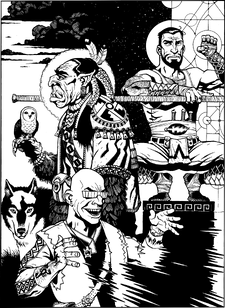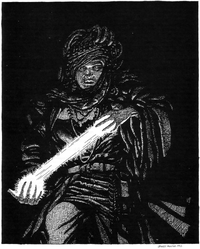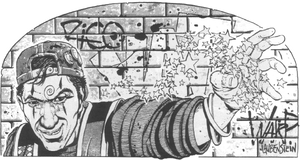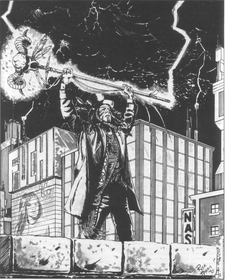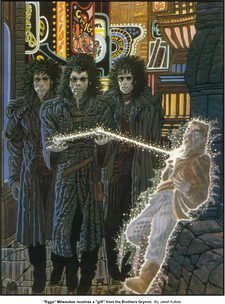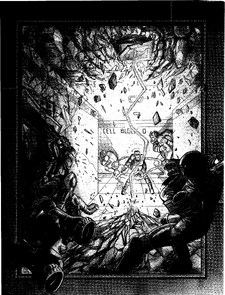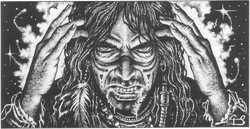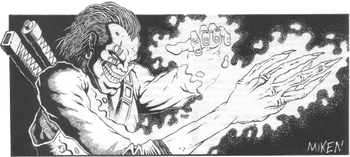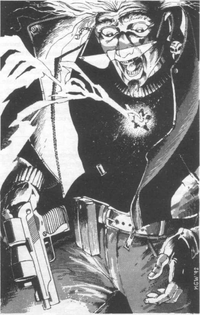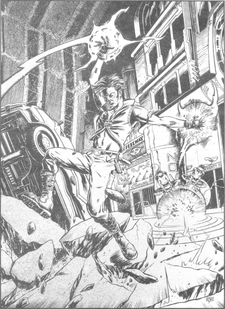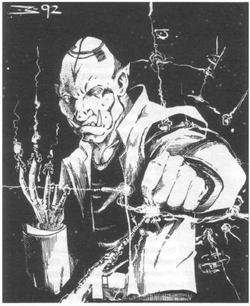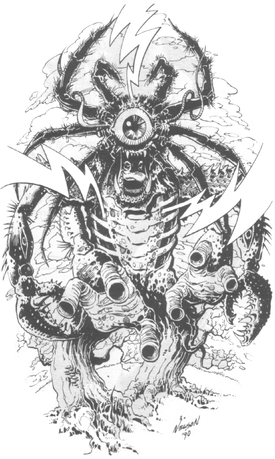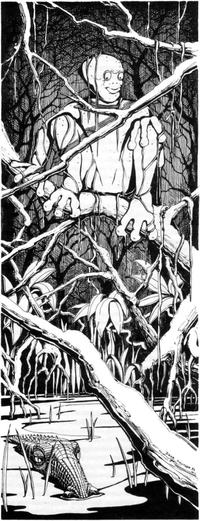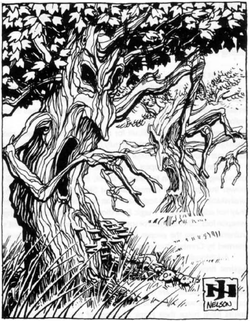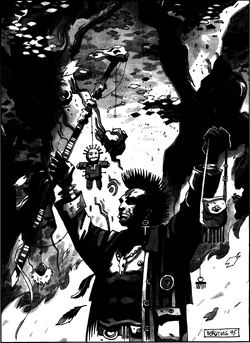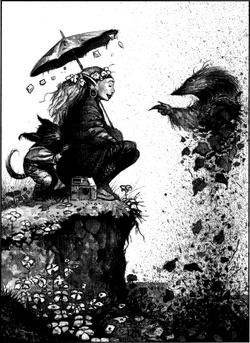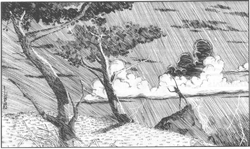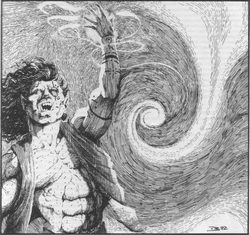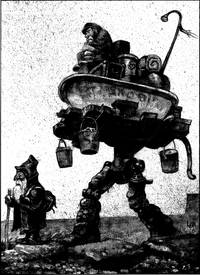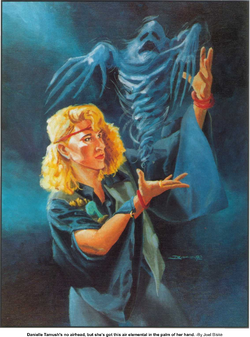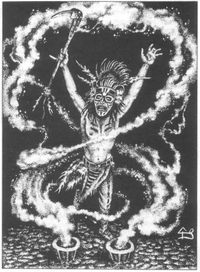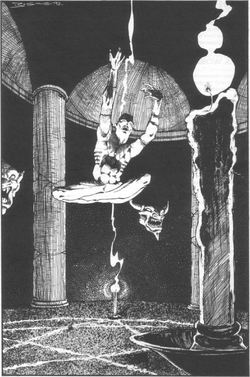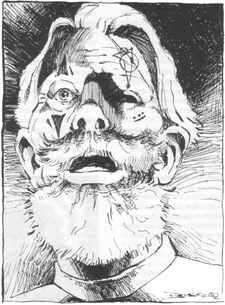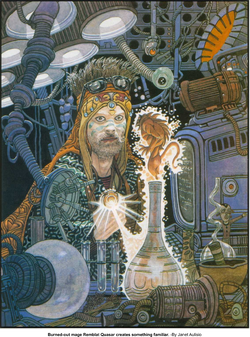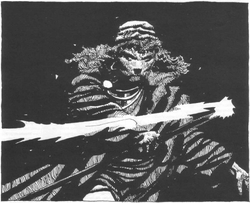Difference between revisions of "Grimoire"
m (→Types of Foci) |
|||
| Line 581: | Line 581: | ||
[[File:SR2Grimoire_InsectShaman.png|right|250px]] | [[File:SR2Grimoire_InsectShaman.png|right|250px]] | ||
'''Spell foci''' enhance the casting of a specific spell or type of spell. They might provide mechanical Advantage, negative certain Disadvantages, inflict Disadvantage on the target, or provide some other bonus. | '''Spell foci''' enhance the casting of a specific spell or type of spell. They might provide mechanical Advantage, negative certain Disadvantages, inflict Disadvantage on the target, grant Help, or provide some other bonus. | ||
'''Spirit foci''' aid conjuring. They will generally be specific to a particular type of spirit. | '''Spirit foci''' aid conjuring. They will generally be specific to a particular type of spirit. | ||
Revision as of 10:06, 18 June 2024
Astral Space
Magic Users
Magic users, also known as magicians or the awakened, wield magic power through one of three traditions: hermeticism, shamanism, and physical kineticism.
Magic Lodges
A magic lodge is a stationary collection of symbols, writings, tools, fetishes, and other mystical materials that helps spellcasters record their lore, expand their talent, and practice magic. It’s a basic tool of magicians across the world, about the size of a room. They need it to learn spells, perform rituals, and craft foci. In a pinch they can use it to protect themselves from magical threats.
Magical lodges aren't particularly portable, taking several days to set up and using several thousand nuyen of materials. These materials can be reused when a lodge is moved.
Each lodge is of a specific tradition—shamans use medicine lodges, hermetic mages use hermetic libraries, and physical adepts use training sanctuaries.
Hermetic Mages
A character who chooses the hermetic tradition becomes a mage. A mage sees the universe as a pattern of abstract forces and energies that can be controlled through complex symbols and formulae of power. Where shamanism is intuitive and improvisational, hermetic magic is more intellectual in its approach, relying on observation, theory, practices, and precise execution. Their magic is based on a complicated set of theories that describe the way astral space contracts and intersects with the physical world. As one might expect, there are as many versions of these theories as there are mages.
Though some magicians may like the country life, stereotypically they are urban types. Mages are scholars and often have elaborate libraries and equipment to assist their research and practice.
Hermeticism Origins
Hermetic magic attracted much interest before the Awakening. Occultists, mystics, ceremonial magicians, surprisingly large numbers from all walks of life were studying the disciplines of the mage at the time of the Awakening, reacting variously with surprise, relief, or even dismay to discover that the magic suddenly worked. As hermetic magic requires complex, intellectual, abstract thinking, many of those who awakened to its practice were corporate employees–scientists, analysts, researchers–hobbyists studying magic in their spare time. As such, the corporations picked up on hermetic magic very early on. To this day the corporations employ wage mages in all capacities, but there are very few shamans. (Try telling Coyote he can only have an hour for lunch.)
Hermetic Libraries
Mages spend a lot of time doing research. They need extensive reference libraries for many activities: learning new spells, designing magical rites, summoning spirits, and so on. The specific contents determine its useful at various tasks, with different mages varyingly specializing their libraries in sorcery, conjuring, magical theory, etc.
Mages can share libraries. Access to the thaumaturgical section of any big university library or corporate reference department lets any number of mages pursue projects at the same time.
A mage may make use of multiple libraries. A hermeticist might maintain a small personal library at home, barely more than a few books on a shelf and a collection of datachips, while making use of a larger, shared research library for more in-depth research.
Shamans
A character who chooses the shamanic tradition becomes a shaman. Shamans receive their power through linking their own inner world of emotion, will, and faith with the external world of nature. This link with nature is personified through a totem, an animal figure that exemplifies the shaman's beliefs and way of life. Totems choose the shaman, waiting for the potential shaman to either heed the call or reject it, such as by choosing an alternate awakened path. Players should also note that a totem is not just a "bear" or even "the bear." The totem is Bear, the archetype for all bears in the world. A totem is not just an animal, but the essence, or true spirit, of that animal.
Shamans are in tune with the ways of nature and life. They are concerned with the maintenance and preservation of their environment, be it the wilds of the Pacific Northwest. the expanse of the Sahara, the majesty of the Amazon rain forests, or the wonderfully complex ecosystem that is a modern city. All is nature, whether it be rocks, streams, trees, and animals, or concrete, steel, neon, and humanity.
Before the awakening, those practicing shamanic traditions would often wear masks to embody their totem. While some still wear them, they are no longer necessary. When a shaman performs magic, the physical traits associated with the totem become more apparent in him. The more powerful the magic, the more noticeable these animal traits become. This is a matter of appearance, not an actual shapechange, and is only visible to the living and spirits. A minor spell might cause an Eagle shaman's features to take on a sharper cast, while with the most powerful spells their features might completely dissolve within the image of a mighty eagle's head.
Shamanism Origins
A shaman's magic comes from the world of nature and the power of emotions. In days past, some "civilized" scholars disparaged shamanism, calling it "primitive" nature worship. When the Awakening came, however, these "backward" primitives knew how to use their new power to pay back the governments and corporations that had oppressed their people for so long. Indeed, shamanism had developed even among some city-dwellers during the boom in occultism at the close of the 20th century. When the magic came back, these "urban shamans" found that the old ways worked well in cities, too.
Medicine Lodges
The medicine lodge is the sacred place of the shaman. It is a little, isolated world where powerful magics can be worked and it is a place for communication with the spirits. Here is where the shaman keeps the special items that are actually and symbolically powerful for him. It is the place where the world of the shaman bridges the worlds of the magical and the mundane.
Shamans generally set up their medicine lodges in or adjacent to the natural habitat of the shaman's totem. A Bear lodge is traditionally set up in the forest, a Turtle lodge along the water, a Bat lodge within a cave. However, some shamans, particularly urban shamans, will create lodges that recreate elements of their spirit's natural environment in order to make their totem spirit more comfortable. An urban Kangaroo shaman may cultivate eucalyptus and palm lily, while an inland Shark shaman would surround themselves with aquariums.
Shamanic lodges may be shared between shamans of the same totem, though the spirit will expect a more elaborate lodge the larger the group of shamans. Many Native American tribes maintain elaborate permanent lodges, be it a hogan, teepee, kiva, cave, or pueblo, for rituals, spiritual communion, and other group activities.
A shaman may make use of more than one medicine lodge. For example, an urban shaman of a non-urban totem may maintain a modest home lodge for simple ritual casting and spirit conjuration, while making use of a more elaborate and extensive nature lodge for learning new spells and other tasks involving deeper communion.
Physical Adepts
A character who walks the path of physical kinetic discipline becomes a physical adept. A physical adept is concerned with mastery and perfection of the physical body in order to achieve a state of inner harmony. A physical adept can do little that does not directly involve their own body, but that is usually enough.
Kineticism Origins
A physical adept is dedicated to improving the body and its abilities. Powers attributed to legendary martial artists, warriors of shamanic peoples, berserkers, and the like, suggest that such adepts may have existed before the Awakening. The first publicly documented physical adept in modern times was Francis Daniels, an engineering Ph.D. and fourth dan ki-aikido black belt. Much of the current understanding of the abilities of the physical adept are due to research Daniels conducted before his untimely death in the riots attending the collapse of the U.S. government in the Washington D.C. metroplex in 2030.
Training Sanctuaries
Training sanctuaries are where physical adepts can practice their disciplines, meditate, and enhance their skills. These sanctuaries vary depending on the adept's focus, whether it be martial arts, acrobatics, or other physical pursuits. While an adept my use a traditional gym or dojo to practice portions of their art, they also need a space to expand their consciousness. While this may include meditation areas, sensory deprivation tanks, or zen gardens, some element of it will specifically aid them in channeling this expanded consciousness physically.
Just as other magic users might make use of multiple magical lodges, some practitioners split these functions into different locations. It's not unusual for a physical adept to have a private sanctuary for personal development and a group sanctuary for training and sparring with others.
Alternate Traditions
The above traditions are the dominant ones in North America. Other cultures may study alternate traditions, though their functional elements often have significant similarities to the North American traditions in practice due to the fundamental underlying nature of magic.
Sorcery
Sorcery is the art of spellcasting. Through it, a magician can command and shape the forces of astral space to a specific end.
Hermetic Spellcasting
Hermetic mages command the astral forces through very specific, practiced, precise formulas. Most of the effort is mental; the exercise of commanding the forces is a task of mental gymnastics and willpower. Some physical activity accompanies the spell, but it is minor compared to the work the mage's mind is doing. Perhaps some words must be spoken, a minor gesture be made, or some symbolic material be used in some manner. Regardless, the mage calls up the mental multidimensional image of the spell formula, imposes it on the forces of reality at hand, then shapes, channels, and directs them to the desired end. The casting of a particular spell is an identical procedure each and every time, unless some parameter of the spellcasting has changed.
Shamanic Spellcasting
Shamans, however, rarely cast magic the same way twice. Their magic comes from intuition, improvisation, and an understanding of the moment. The forces of nature are called, not commanded. The shaman considers the forces of nature to be allies, not tools, allies to be praised for their assistance. The specifics of a shaman's spellcasting vary with the moment and the situation. The calling of powers is very personal and must be tailored to the situation. Each dance, each chant, each song is different because each moment is different. Thus, each spellcasting is different. Like the mage, the shaman uses his mind to call on the unseen forces of magic, but his spellcasting has more external components in the form of dances, gestures, chants, or songs. Most of this is voluntary, however. When necessary, the shaman can call the forces of nature with barely a whisper.
Types of Spells
Physical spells affect physical things. The magical energies of a physical spell are synchronized with the tangible aspects of a target: its composition, mass, momentum, appearance, and so on. Only physical spells can affect inanimate objects such as walls. rocks, and the like. Physical spells can affect living things, but they affect the physical nature and structure of the being.
Mana spells affect the intangible elements of a target, such as the spirit or emotions. They are the only spells that can affect purely magical targets. Mana spells cannot affect inanimate objects on any level.
Spell Categories
Combat spells are quick, dirty, and violent. The energy of combat spells is channeled into the target directly from astral space through the target's aura. The target is, effectively, attacked from within. Combat spells ignore the effects of armor and non-magical, external protections. The target of a combat spell must, however, be within line-of-sight of the casting magician. The magician must be able to see the target, directly. The magician can ignore transparent obstructions such as clear glass, but not smoked or one-way glass. If the magician cannot see the target, he cannot affect the target, even if he is absolutely certain that the target is there, just out of line-of-sight.
Detection spells are used to enhance the senses or to analyze the environment. They allow the magician, or the recipient of the spell, to sense things in a manner normally beyond his or her ability, to see or hear from a great distance, and so on. There are also spells that allow the magician to detect the presence of other beings, magic, life, and enemies.
Health spells are concerned with the condition and performance of the body. They can be used to treat or heal injuries, purge poisons or toxins from a body, or improve physical performance.
Illusion spells fool the senses. They can be used to deceive, create things that do not really exist, make things invisible, stimulate the senses, or provide simple or complex entertainment.
Manipulation spells can transform, transmute, control, or animate matter or energy. They are powerful, complex spells that are difficult to control and master. Manipulation spells can control the emotions or actions of a person, move objects or items, shape, create, or channel energy such as light or fire, or change a target's form or appearance by changing its structure. Unlike combat spells, a manipulation spell used for a violent, destructive purpose actually creates a tangible physical effect. A blast of flame from a manipulation spell strikes the target from the outside, which lets the target benefit from the protection of armor and such. Combat spells strike from within, bypassing armor. Manipulation spells, however, do not have the same line-of-sight restrictions as combat spells.
Spell Targeting
In choosing a target or targets, the magician can choose anything within sight. Sight is the key concept. Magicians cannot directly affect what they cannot see. Binoculars, glasses, telescopes, and other devices can enhance vision for spellcasting, as can any magic or technology that penetrates darkness.
A magician cannot, however, cast spells directly at invisible beings or beings in astral space except by using enhanced vision or astral perception, as appropriate. Remote vision, such as through a telecom screen, security camera, or a remote-sensing spell like clairvoyance are also useless for casting spells.
A good rule of thumb is that magicians must be able to see their targets with their own eyes or a natural extension of those eyes. The image of the target must be the original image; nothing that translates the image into another medium works. So, optical binoculars work fine for spellcasting, but electronic binoculars that digitize the light from the image and computer-enhance it would not work.
Mirrors work fine, and transparent glass is no hindrance, but unless the mage is on the "see-through" side of a one-way mirror, that would not work either. Cybereyes work because the magician has invested their essence into them. The remote cameras of a drone, however, would not work.
Possible Mechanical Modifiers
Magicians may stack multiple spells into one long spell and then cast them simultaneously. While this is at greater difficulty (mechanically, they'll generally take Disadvantage), it can allow them to simultaneously produce complex combined effects.
Similarly, sustaining an ongoing spell, absent a sustaining focus, requires mental attention. This makes it more difficult to cast a second spell with a first already going (mechanically, generally inflicting Disadvantage).
Injury, disability, or impairment affecting the ability to concentrate can disadvantage spellcasting.
Difficulties perceiving a target can disadvantage spellcasting. See Spell Targeting.
While armor or other physical protection doesn't generally affect spells, magical protection, such as from a mana barrier, may disadvantage spellcasting. Mages that erect such a barrier are not disadvantaged by it.
Casting spells from within a magic circle or magic lodge by anyone other than the mages or shamans who created or maintain it is disadvantageous.
Spells with a touch requirement (hand-to-hand physical contact must be made) are disadvantaged by any difficulties in touching the target.
Noticing Spellcasting
Just how obvious is spellcasting? Not very, unless the observer knows what they are looking at and is paying attention.
Magicians and others families with spellcasting find it easier to notice, particularly magicians of the same tradition who are familiar with the type of spell being cast. More powerful spells (producing larger effects, affecting larger groups) are more noticeable, less powerful less noticeable.
Independent of the above, an astrally projecting or perceiving character automatically notices the colorful astral display associated with spellcasting.
Learning Spells
Before a magician can cast a spell, it must be learned. It can be learned from another magician who already knows it or designed from a spell formula.
The cost of learning a spell includes acquiring a teacher or formula, acquiring magical materials used in the process of study, and the time and effort invested in studying.
To learn a spell, a shaman must spent time in their medicine lodge practicing it. Similarly, a hermetic mage must spent time practicing in their hermetic library.
A shaman learning a new spell spends time chanting, dancing, and carrying on. This whips up the kind of emotional peak shamans need to contact the spell energy. A mage spends time in meditation, intense study, and formal ritual. For either, learning a spell requires a week or two.
Shamans and mages make bad neighbors and worse roommates. The differences between "hermetic nerds" and "party shamans" are a running gag on the popular trivid series "The Odd Coven".
– Dowd
Kinetics
Spirits
Though magicians and occultists are still arguing about whether spirits have a separate existence of their own or whether they spring purely from the formless energies of astral space at the time of conjuring, it does not much matter for all practical purposes. Beings of astral energy regularly appear within astral space with consistent properties and a modern magician needs to expect to deal with them.
Spirit Form
Spirits can appear in one of three forms: astral form, manifest form, and great form.
In astral form, the spirit exists entirely within astral space, though it may be noticeable as a slight shimmering in the air. A spirit in astral form can be sensed by magicians using astral perception or projection, though, if summoned, it may communicate with its summoner without them having to astrally perceive. Their appearance in astral space depends on the type of spirit (see descriptions below). While in astral form, spirits can only perform actions that directly affect entities present in astral space, with the exception of a spellcaster who has summoned them, with whom it can perform certain services even if the summoner isn't astrally perceiving or projecting.
While the spirit is in this form, physical weapons cannot harm it. Weapon foci that have an image (an existence) in astral space can harm a spirit in astral form, but the wielder must be using astral perception or projection to use it properly. The "shimmering air effect" cannot be attacked by a weapon focus or be targeted by spells. Spirits can also be attacked by banishing (again the magician must be actually seeing them) or by astral combat.
Spirits assume manifest form when they must use a power against a target that has only a physical presence and is not present in astral space. Instead of a slight shimmering in the air, they visible take on the appearance they had in astral space.
Spirits dislike manifest form because it makes them vulnerable to physical attacks. Even so, it is very difficult for non-magicians to damage a manifest spirit: they strongly resist anything but magical attacks and weapon foci, and are all but immune to modern ranged weapons like firearms and explosives.
In rare circumstances, spirits can take on a great form. A great spirit can exercise its powers over a far larger area and with greater effect than can a spirit in astral or manifest form. Like manifest spirits, great spirits are resistant to non-magical damage and immune to modern weapons like firearm and explosives. Great form spirits take on more impressive and awe-inspiring appearances than normal.
Only summoners with the proper initiation can conjure a spirit in its great form.
Elementals
Anima hermetica
Existing primarily in astral space, elemental spirits are the forces of the classical magical elements (fire, water, air, and earth) engendered into seemingly self-aware entities. Each type's appearance is peculiar to its element, with the size of its manifestation almost always indicative of its power. They may be conjured, or in rare events spontaneously erupt, near a concentration of its element.
Each type of elemental has special powers and weaknesses. Each is subject to annihilation by contact with an opposing elemental of equal or greater power, during which the stronger elemental is weakened by the power of the other as well. Fire opposes water, and air opposes earth. All elementals can manifest physically. All elementals are vulnerable to attacks of their opposing element. All elementals may be resisted using equipment that protects against that associated element.
| Air | Powers: Engulf, Manifestation, Movement, Noxious Breath, Psychokinesis |
|---|---|
| Attacks: per powers | |
| Earth | Powers: Engulf, Manifestation, Movement |
| Attacks: heavy blows with long reach | |
| Fire | Powers: Engulf, Flame Aura, Flame Projection, Guard, Manifestation, Movement |
| Attacks: ranged fire blasts | |
| Water | Powers: Engulf, Manifestation, Movement |
| Attacks: disorienting blows |
Nature Spirits
Anima naturalis
Nature spirits are the embodied forces of nature and of place, and the spirits of shamanic tradition. There are four classes of nature spirit: Spirits of the Land (forest, mountain, desert, prairie), Spirits of the Waters (sea, lake, river, swamp), Spirits of the Winds (storm, mist), and Spirits of Man (city, field, hearth).
Nature spirits rarely appear in any fixed form. When they do manifest, it is often in a form that reflects their home terrain. The Spirits of Man are the major exception to this rule, as they usually assume humanoid form. The ancient legends of "brownies" are probably memories of these spirits manifestations. If conjured by a shaman of great power, these spirits may appear in a shape somewhat similar to that of their summoner, but composed of the matter of their home terrain.
Nature Spirit Domains
Nature spirits can only exist in their home terrain. They cannot be summoned anywhere else, nor will they obey orders that send them from home. Thus, a sea spirit will not move onto land, a prairie spirit will not enter a forest, and so on. Nor can their powers affect other domains or any targets in them.
Some nature spirits have domains that may seem to cross into other domains, but it is never the case. The domain of a broad-environment spirit is always superseded by the domain of a limited-environment spirit such as a hearth spirit. So even if an extremely rich person had a spacious home with the air-space equivalent of an aircraft hanger it would still be the domain of a hearth spirit and not one of the sky spirits.
Domains are very restrictive. A city spirit can exercise search power on the streets, squares, and plazas of a city. It cannot, however, successfully search if it is inside an occupied building (hearth spirit territory), a park (forest spirit), in a boat on the river (river spirit) or on Puget Sound (ocean spirit).
| Spirits of Man | |
|---|---|
| City | Powers: Accident, Alienation, Concealment, Confusion, Fear, Guard, Manifestation, Search |
| Domain: streets, plazas, alleys, open areas, and abandoned buildings of a city | |
| Appearances vary widely. City spirits usually appear as small pieces of litter or amorphous masses of garbage. There is, however, a documented case of a spirit in San Francisco that appeared in the form of a cable car, and a shaman in Seattle recently claimed that he conjured a spirit that took the form of a 1947 Hudson automobile. | |
| Hearth | Powers: Accident, Alienation, Concealment, Confusion, Guard, Manifestation, Search |
| Domain: homes, residences, and occupied buildings | |
| Hearth spirits often resemble small, bearded humanoids wearing antique clothing. | |
| Field | Powers: Accident, Concealment, Guard, Manifestation, Search |
| Domain: cultivated and worked fields and growing areas | |
| Special Power: Field spirits can improve the fertility of crops and livestock. Conversely, they can also damage crop or ranch yield. | |
| Field spirits take the form of miniature farmhands dressed in overalls, bandanas, and so on. Reports of field spirits wearing chaps, ten-gallon hats, and elaborate cowboy boots in the North American Southwest remain unverified at this time. | |
| Spirits of the Land | |
| Desert | Powers: Concealment, Guard, Manifestation, Movement, Search |
| Domain: open desert | |
| Desert spirits appear initially in the form of small dust devils that, fi ordered to attack, grow into raging sandstorms. | |
| Forest | Powers: Accident, Concealment, Confusion, Fear, Guard, Manifestation |
| Domain: forests, as well as decent-sized parks | |
| Forest spirits rarely manifest visibly. When they do, they appear as deeper pools of shadow among the trees. If a shaman orders them to take a more solid shape, they become vaguely humanoid trees, capable of Movement, with great, knobby, branch-like limbs. | |
| Mountain | Powers: Accident, Concealment, Guard, Manifestation, Movement, Search |
| Domain: rugged mountain terrain | |
| Mountain spirits rarely have physical manifestations. Their arrival is marked by an utter stillness and an oppressive, invisible presence. If forced into visibility, the mountain spirit becomes a craggy humanoid of apparently living rock, which despite its small size, has an aura of enormous mass. | |
| Prairie | Powers: Accident, Alienation, Concealment, Guard, Manifestation, Movement, Search |
| Domain: open land, uncultivated fields, tundra | |
| Prairie spirits typically appear as erratically moving tumbleweeds or small dust devils. Reports of miniature riders resembling nomadic human types such as Mongols and Amerindians are under investigation. | |
| Spirits of the Sky | |
| Mist | Powers: Accident, Concealment, Confusion, Guard, Manifestation, Movement |
| Domain: mist, fog, rain | |
| Mist spirits have no material form, appearing only as swirling clouds of fog. | |
| Storm | Powers: Concealment, Confusion, Electrical Projection, Fear, Manifestation |
| Domain: thunderstorms, hurricanes, tornadoes, violent storms | |
| Storm spirits initially manifest as cold, damp presences. When conjured with strength, they appear as roiling thunderclouds or whirlwinds. Undocumented manifestations as an eagle in the western portion of North America and a red-bearded giant in a goat-drawn chariot in northern Europe have also been reported. (Accounts of winged humanoids with bowling balls can be safely discounted.) | |
| Spirits of the Waters | |
| Lake | Powers: Accident, Engulf, Fear, Guard, Manifestation, Movement, Search |
| Domain: open lake water | |
| Lake spirits usually appear as an area of ripples upon the water. If the shaman conjures them into more solid form, they will appear as humanoids dripping with moss and weed, rising from the water. | |
| River | Powers: Accident, Concealment, Engulf, Fear, Guard, Manifestation, Movement, Search |
| Domain: rivers, large streams, river deltas (when not swampy). inlets and outlets | |
| River spirits usually appear as small whirlpools, but under constraint, they may appear as small, frog-like, weed-draped humanoids. | |
| Sea | Powers: Accident, Alienation, Concealment, Confusion, Engulf, Fear, Guard, Manifestation, Movement, Search |
| Domain: the open sea | |
| Sea spirits usually appear as anomalous surfaces on the water: choppy waves in a calm sea and tranquil patches in a choppy sea. If forced to take on a more solid form, they resemble merfolk, mythical creatures with humanoid upper bodies and hind bodies of fish. | |
| Swamp | Powers: Accident, Binding, Concealment, Confusion, Engulf, Fear, Guard, Manifestation, Movement, Search |
| Domain: swamps and marshes | |
| A swamp spirit typically manifests as a flickering ball of light, and they are believed to be the source of the will-o'-the-wisp legends. Magicians have occasionally reported swamp spirits manifesting as moss-hung trees or rotting masses of vegetation that might only be called humanoid out of charity. | |
Spirit Powers
The use of a spirit power generally involves an opposed check between the spirit and the target of the power. The power descriptions below give the scope of a full success by the spirit. Full success by the target might grant them both avoidance of the effect and short-term immunity to that power. Spirits can only sustain one power at a time.
Accident gives a spirit the ability to cause an apparently normal accident to occur. The nature of the accident and its result will vary according to the terrain the being controls. It trips, gets a mouthful of leaves, or even a cream pie in the face. The accident is not dangerous in itself, but the environment can make it so. A fall on a narrow mountain ledge, for instance, can be most unfortunate.
Alienation gives the spirit the ability to enshroud its victims in an aura that makes the victim invisible to others. A victim will remain under alienation for a few hours, longer for more powerful spirits. Victims of alienation are invisible, intangible, and inaudible to those around them, as if they don't exist at all. Drivers will not stop for them, no one talks to them, their friends shoot through them to hit targets. Despair fils their soul. The target can attempt to briefly shake off the effect to get someone's attention or avoid a dangerous situation, but dispelling the power requires banishing the spirit. The alienation power resists beneficial use, preventing any activity where invisibility might be useful.
Binding gives a spirit the power to make its victim "stick" to a surface or to itself.
Concealment lets a spirit hide itself, its companions, an object, or an area from being found. This is not invisibility, but an ability to hide within the terrain. It is opposed by those who seek what is hidden.
Confusion gives a spirit the ability to make its victims lose their sense of direction and wander in confusion through the terrain it controls. The consequences may vary widely. A hearth spirit causing confusion in a house might lead to nothing worse than someone bumping into walls or mistaking a closet door for an exit. Confusion in the realm of a mountain spirit could easily lead someone to topple off the nearest cliff. The power remains in effect as long as the victim remains within the area of terrain controlled by the being. Targets take Disadvantage to all tasks and must make a check to assert their willpower to make any decision; on a Twist, they fail to make up their mind until someone or something intervenes to force a decision, at which point they may retry. If left alone, characters in this state inevitably wander off.
Electrical Projection gives a spirit the power to strike a target with a discharge of electricity. Depending on the being, results may range from a mild shock to a lightning bolt. Attacks tend to be meaningfully dangerous and can cause short-term disorientation and impairment.
Engulf gives a spirit the ability to draw its victim into itself or the terrain or element appropriate to its nature. The victim is subject to all effects of being submerged in the substance, the least of which is usually suffocation. Air spirits can use this power to influence the local composition of the air, such as by removing oxygen.
Fear gives a spirit the power to fill its victims with overwhelming fear of either the terrain or of the being. The victim will race in panic for the nearest point of apparent safety.
Flame Aura gives a spirit the ability to make its surface ripple with flame, burning any who touch it. Intense forms of this power may make wooden weapons burst into flame at a touch or even melt metal or plastic weapons. Any successful melee attack against a creature with flame aura power means that the attacker also takes damage from the intense heat.
Flame Projection empowers a spirit to project flames, often in the form of fiery breath. When sustained over time, the influenced area will grow larger. Highly flammable items may be ignited by a flame projection attack.
Guard gives the spirit the capacity to prevent any accident–both natural and those caused by accident power—within the terrain they control.
Manifestation empowers a spirit to temporarily manifest in the physical world.
Movement empowers a spirit to increase or decrease its target's movement rate within the terrain it controls, multiplying or dividing it by double or more.
Noxious Breath causes the spirit's breath to incapacitate its victims. Normal armor doesn't protect against this, though breathing gear does.
Psychokinesis empowers a spirit to generate psychokinetic energy that allows it to apply force at a distance, similar to the magic fingers spell.
Search empowers a spirit to seek any person, place, or object within its terrain. Opposed by the target of its search or someone responsible for concealing it.
Conjuring
Through conjuring, a magician can summon, control, and banish different kinds of spirits.
The two types of spirits that can be summoned with relative ease are nature spirits and elementals. Nature spirits personify the forces of the environment, and only a shaman can summon or control them. Elementals arise from the four hermetic elements of fire, water, air, and earth, and only a hermetic mage can summon or control them.
Though other kinds of spirits also inhabit the Sixth World, most can only be contacted by very experienced magicians who have significant resources to invest.
Spirit Summoning Basics
Only hermetic mages and shamans can summon spirits. Adepts and other alternate magic users cannot. However, not every mage or shaman has studied or mastered the art, while some focus almost exclusively on it.
Spirits may be summoned at a minor, significant, or major force. A minor desert spirit might take the form of a small dust devil; a minor fire elemental a torch's worth of flame. They're weak, provide minor effects, and stand up poorly to opposition. A significant river spirit might appear as a short frog-like humanoid; a significant water spirit a man-sized mound of water. They're capable helpers and show significant ability when opposed. A major sea spirit might appear as an imposing merman; a major earth spirit a towering figure of rock. They're powerful actors and deploy overwhelming force when opposed.
Mechanically, summoning a spirit involves making an opposed check. The caster makes this with Disadvantage unless they have a relevant skill (e.g., Summoning, Forest Spirits, Fire Spirits). A summoned minor spirit resists with Disadvantage, a major spirit with Advantage, and a significant spirit with neither. Situational Advantage and Disadvantage apply as normal. On success, the summoner is owed a number of services equal to the amount they beat their opponent by. If the mage fails, not only do they fail to bind a spirit, but they may face one or more of an unruly spirit appearing, finding themselves drained (e.g., the Winded or Exhausted conditions), and generating a negative spirit relationship relating to that type of elemental (for a hermetic mage) or that type of domain (for a shaman) until amends are made.
When summoned, a spirit first appears in its astral form, fully visible on the astral plane, marginally visible in the physical world as a slight shimmering in the air. The more powerful the spirit, the more noticeable this effect. Once summoned, a spirit can be asked to wait away from the summoner to be called when needed, though a subtle astral trace remains between them until it is released.
Spirits generally prefer to remain in astral space unless they are ordered to manifest or need to manifest to follow a command. Ordering a spirit to manifest does not use a service of the spirit or require a skill check to command, barring very unusual circumstances (e.g., acting while impaired by the Confusion ability).
Summoning Nature Spirits
Only a shaman may summon a nature spirits. Nature spirits are quick to summon, taking only a few moments of concentration while standing in one place. Unlike with a hermetic mage, no material components are required. All a shaman needs is a quick song, dance, or other cry out for assistance. A shaman can only have one spirit in their service at one time.
A shaman can summon a nature spirit only in that spirit's home domain. A domain is the environment that spirit personifies: storm spirits require open air, forest spirits heavy woods, hearth spirits an occupied home, and so on. A shaman cannot summon a spirit from outside the spirit's domain. A shaman could not, for example, summon a storm or forest spirit inside a home. A home is the domain of the hearth spirit. Nature spirits only have power within their domain and cannot cross out of that domain nor extend their power from it.
Nature spirits vanish at sunrise and sunset, no matter what, and regardless of whether the sun is actually visible or not. All service by the spirit ends at that time and any services left unused or unspecified by that time are lost.
Summoning Elementals
Only a hermetic mage can summon an elemental. Summoning elemental spirits requires several hours, more for more powerful spirits, less for less. The mage will also need a conjuring library with adequate materials, a conjuring circle of sufficient power, and a quantity of one-use materials, available from talismongers, determined by the power of the elemental being summoned: 1k¥ for the weakest elementals, higher for more powerful.
Each elemental also needs a source. Fire elementals arise from great bonfires (indoor mages, beware of sprinkler systems), a fireplace, a large brazier, or the like. Water elementals come from a large pool or tub of water. (This requirement is satisfied if the hermetic circle is near a body of water.) Air elementals need great quantities of burning incense (watch out for smoke detectors, too). Earth elementals need a large (man-sized) heap of earth, clay, or rock. This requirement is satisfied if the place of working is on open ground.
An elemental that owes services to a mage is considered bound to that mage, but the mage need not use all the elemental's services at one time. At the time of its summoning, the elemental is bound and effectively placed on notice to respond to calls from the mage. The elemental then departs, through astral space, for parts unknown. There it remains until called to serve.
Most hermetic summoners can keep only two or three elementals bound to themselves at any one time, though this limit may be increased with proper initiation.
Spirit Commanding Basics
A spirit that is not present with the magic user must first be recalled before it can be commanded. This isn't difficult, but it takes a moment of time. Recalling a spirit does not count as the use of a service by the spirit. It generally does not require a skill check, unless the magic user is attempting to maintain another magical effect at the same time or some other complication exists.
Spirits are summoned with a specifically-determined number of services to its summoner. After these services are used the spirit is freed and will flee. Spirits can only perform tasks within the scope of their powers and abilities. Spirits cannot be assumed to be able to perform mundane tasks. Having a spirit use combat powers on behalf of its summoner only expends one service for the duration of the combat, regardless of the number of foes involved.
Commanding a spirit does not generally require the use of a skill check, barring unusual circumstances, though particularly complicated commands might benefit from skill with spirit communication.
Spirits make their own checks to take action. Generally, minor spirits roll with Disadvantage, major spirits with Advantage, and significant spirits with neither. However, contextual Advantage and Disadvantage still apply. For example, even a minor flame elemental doesn't face Disadvantage for lighting a candle (and probably wouldn't even need to roll). The summoner may spend Action Points on behalf of their summoned spirit so long as they have a relevant skill or character element to justify it.
Powers that directly protect or benefit the summoner, such as concealment, guard, or movement, can be used while the spirit is in astral form. To use its powers on others, however, a spirit must assume its manifest form.
Commanding Nature Spirits
Once summoned, a nature spirit can be commanded to use one of its powers with the use of one service. These powers are specific to the spirit summoned. Continual use of a specific power only requires one service, even if the power affects multiple targets. However, if the shaman wishes to change the parameters of its use, say by requesting that the spirit use concealment power on more characters than previously, this uses an additional service.
Nature spirits do not need to stay within line-of-sight of their summoner when performing services, but as usual they cannot leave their domain nor target people or things outside their domain.
Commanding Elementals
There are five types of services that an elemental can perform: aid sorcery, aid study, spell sustaining, physical service, and remote service. Each of these costs one of the elemental's services to initiate. Sending an elemental away to wherever elementals go and placing it on notice for calling at a later time does not cost a service. An elemental may only perform one service at a time.
With the exception of remote service, the elemental must remain within line-of-sight of the mage when performing a service. The use of astral senses, clairvoyance spells, or other magical senses fulfill this requirement, but electronic viewing does not. A mage cannot "remote-control" an elemental using a trideo camera or system.
The magician who summoned the elemental can order the spirit to obey another character, whether magician or mundane. Mundanes cannot use elementals to cast spells, but they otherwise receive the same services as a mage: defensive aid, sorcery, physical service, and so on. Elemental bodyguards are rare, but they do sometimes protect politicians, corporate execs, yakuza oyabun, and other big noises.
At the end of each twenty-four hour period that passes after an elemental is summoned, if at any point during that twenty-four hour period the spirit was present with the summoner, performing a service, or otherwise present on the material or astral planes, one additional service is used up. An elemental which is merely available for recall deep in astral space for the entirety of a twenty-four hour period does not use up a service in this way. The initial summoning of an elemental, if it is allowed to immediately depart for astral space, does not invoke the use of a service.
Elemental Services
The aid sorcery, aid study, and spell sustaining services all have elementals assisting with the practice of magic. In each of these tasks, they may only assist with a category of spells determined by their element type: fire with combat, water with illusion, air with detection, and earth with manipulation. No type of elemental can assist with healing spells. Elementals can only assist hermetic magic.
The Aid Sorcery service has an elemental assist a mage in casting spells of the appropriate category. For the cost of one service: a minor elemental provides Help with one spell; a significant elemental provides Help with three spells or Advantage on one; and a major elemental provides Help with all spells for a scene or Advantage on one, ignoring all Disadvantages. An elemental may remain in its astral form and provide this service.
The Aid Study service has an elemental assist a mage in learning a spell of the appropriate category. The elemental doesn't teach the spell, but instead aids the mage in the process of learning. The mage must have all the normally-required elements for learning the spell. More powerful elements provide more substantial assistance. An elemental may remain in its astral form and provide this service.
The Spell Sustaining service has the elemental sustain one spell of the appropriate category. A minor elemental only sustains a spell for a few seconds, a significant for a single minute, a major for several minutes. If a spirit is banished while sustaining a spell, the spell ends. An elemental may provide this service while in its astral form.
Spell Binding is a variant of sell sustaining that persistently binds the spirit to sustain the spell. This uses up all the remaining services of the spirit. A minor spirit binds a spell for one day (twenty-four hours). A significant spirit for three days. A major spirit for one week. The spirit may be dismissed before that time is up, at which point it is unbound and flees. An elemental may provide this service while in its astral form.
Physical Service has an elemental manifest and use its powers to some end. A fire elemental could be called to burn through a door, for example, or an earth elemental to move a great weight, or any kind of elemental to fight some enemy. More powerful spirits produce more significant effects. Physical service always requires the elemental to assume its manifest form.
Remote Service must be specified for the elemental when it is first summoned. The spirit isn't bound but instead must be immediately commanded to perform a particular job, which could be any of the other services. The elemental will single-mindedly pursue the task until it is either accomplished or the spirit is banished or destroyed. Because the elemental is not bound it does not count against the mage's limit on bound spirits, but by the same token even the summoning mage cannot command an elemental to abandon its task once it has been set loose. Remote service may involve either or both of the astral and manifest forms.
Ritual Magic
Ritual magic is an alternative method of performing sorcery and conjuring. While much slower, requiring hours to perform, rituals allow multiple magicians to cooperate, can produce effects over wider areas, and otherwise affect more people are perform more difficult tasks. Perhaps most usefully, they also allow magicians to cast spells on targets that are not within visual range.
Magic Circles
Ritual magic requires a magic circle to be performed, whether a hermetic configuration or shamanic spirit ring. A magic circle is specific to a particular tradition (hermeticism or shamanism) and to the specific spell or conjuring being performed. A magic circle for a stink spell can't be used to perform a healing spell. A magic circle for summoning a fire elemental can't be used to summon a water elemental.
A circle can be in any convenient, private place, indoors or out, thought it should be secluded so as to allow the ritualist to focus. Circles require the use of both reusable and one-time resources. A magician can draw on the resources of an appropriately-stocked magic lodge for the reusable components. The cost of the one-time components are:
- Detection and Illusion rituals cost 500-2k¥ for each cast.
- Health rituals cost 2.5k-10k¥ for each cast.
- Manipulation rituals cost 5k-20k¥ for each cast.
- Combat spells cannot be cast using rituals.
The ritual cost is higher for larger effects and larger numbers of targets. Casting the ritual uses up the materials, regardless of the outcome.
Magic circles for hermetic mages and shamans tend to look quite different. Hermetic configurations are highly geometric and filled with arcane formulae. Spirit rings are constructed from arrangements of natural elements, plant or animal, forming a space that the shaman finds conducive to performing magic. While mages commonly customize their configurations to their own magical theories, they tend to duplicate the same magic circle each time they cast the same spell. In contrast, shamans will vary the spirit ring based on what feels rights for the local environment, both physical and astral.
Constructing a magic circle might take as little as half an hour or take several hours depending on the ritualist's familiarity with the ritual, the available assistance, the scope of the planned ritual, and the presence of any confounding physical or astral considerations. Setting up a ritual circle in the ritualist's own magic lodge is generally much quicker and easier.
Ritual Teams
Ritual magic lets magicians cooperate in performing magic. The magicians must belong to the same tradition, but shamans of different totems may cooperate in a ritual team. Physical adepts may not lead rituals, but may assist them; physical adepts that learn to assist in rituals must select either shamanic or hermetic magic as their associated tradition.
Ritual Sorcery
Ritual Sorcery Targeting
If the magician cannot see the target of ritual sorcery, they need a material link to perform the ritual. If the target is a living being, the material link is a tissue sample that contains the being's DNA pattern. If the target is not a living being, the magician needs an integral piece of its structure. The magician could, for example, target a building using a brick pried from one of its walls, but they could not use a picture that once hung inside.
If a ritual team is involved in the spellcasting, however, one of its members can astrally guide the spell toward its target, making a material link unnecessary. In astral guiding, an astrally-projecting team member is used to "spot" the target in astral space, making a material link unnecessary. This team member does not provide assistance (e.g., Helping or Advantage) other than this guidance. The guiding team member must be physically present at the ritual casting and project to maintain astral line-of-sight to the target for the duration of the ritual.
Ritual Conjuring
Initiations
Foci
Foci are items of magical power used by magicians. While they may have practical use to the mundane (a knife is still a knife), their magical ability may only be used by the awakened.
Foci are created through enchantment, a specialized skill learned by some magicians, and sold by talismongers. A magic user's tradition does not need to match that of the enchanter who made the focus, though most prefer equipment matching their art.
A focus must be bound to the magic user before it can be used. The process of binding a focus is specific to the magic user's tradition, but always takes several hours. Binding involves the use of one-time resources, typically ranging from a few hundred to a few thousand nuyen in value, depending on the power of the focus.
A focus must also be activated before it can be used. Mechanically, it generally does not require a check, but it is a separate action from using the focus, thereby taking up a small amount of time, similar to drawing a weapon. By default, a magic user may have at most two foci active at a time, though this limit may be increased through initiation.
A focus is apparent to astral perception, but does not qualify as an active magical effect merely for existing or even being bound. An astral trace extends from a bound focus to the awakened it is bound to, even if it is inactive. An active focus is dual-natured and draws obvious attention in astral space, similar to an active spell. An astrally-projecting mage may bring active foci with them when traveling.
Types of Foci
Spell foci enhance the casting of a specific spell or type of spell. They might provide mechanical Advantage, negative certain Disadvantages, inflict Disadvantage on the target, grant Help, or provide some other bonus.
Spirit foci aid conjuring. They will generally be specific to a particular type of spirit.
Power foci help magicians channel magical energy beyond what they could normally handle. They can be used to avoid suffering mana drain from performing magic, a common Cost of magic use. A power focus can only absorb only so much mana drain in a given cycle, which may be daily, monthly, or yearly depending on its manufacture.
Spell locks are special foci that allow a spell to be sustained on a target without the attention of the caster. The effort of sustaining the spell is transferred to the lock, which channels the necessary astral energy into the spell. The lock must remain in the possession of the target, but the target may then leave the line-of-sight of the caster. The caster does not need to concentrate on the spell, though they may end it at will; an astral trace extends between themselves and the spell for as long as it remains active; and it counts against the caster's limit of bound foci. Every activation of a spell lock requires the use of one-time magical resources (costs the same as for ritual casting).
Weapon foci are enchanted weapons. They may provide many different benefits to the wielder, ranging from extra damage to various supernatural effects. As of yet, no one has found techniques appropriate for enchanting modern weapons like firearms. All attacks with weapon foci overcome spirits' and other astral phenomenon's natural resistance to physical damage, the same as using a mana spell.
Targeting a Focus
There is a disadvantage to having an active focus of any kind. Being a continually powered astral energy, a magical focus creates a continual, open bridge from astral to mundane space. This is dangerous.
A spell cannot normally be cast from astral to mundane space, or vice versa. These two different realms are separated by an interface that can only be crossed under specific circumstances and criteria. Spellcasting is not one of them. This means that characters who are in mundane space, and have no connection to astral space, are safe from any astrally projecting magicians or exclusively astral spirits or creatures.
A focus, by virtue of its nature, creates a pathway between the two realms. Through this channel an astrally present magician can cast a spell at the focus's physical component. Because the spell is affecting the physical materials of the focus, the spell must be a physical type. Because of the connection between an active focus and its wielder, the person using the active focus may be included as a target of the spell. And where the physical spell is area-effecting, the focus may be used as the locus of the area effect, so long as the caster can see the targets in astral space (which does not require the targets to be present on the astral plane). Due to the nature of how this effect works, manipulation spells cannot be used in this manner.
Attacks through a focus like this are opposed by the focus itself. A focus that successfully defends against the attack ignores it and the spell may not be channeled through the focus to affect others. A spell that beats the spell's resistance may affect it, its wielder, and those in the area, as appropriate. An attack that damages a focus renders the focus inactive and unable to be activated until repaired by a qualified enchanter, but does not require its owner to rebind themselves to it once repaired.

